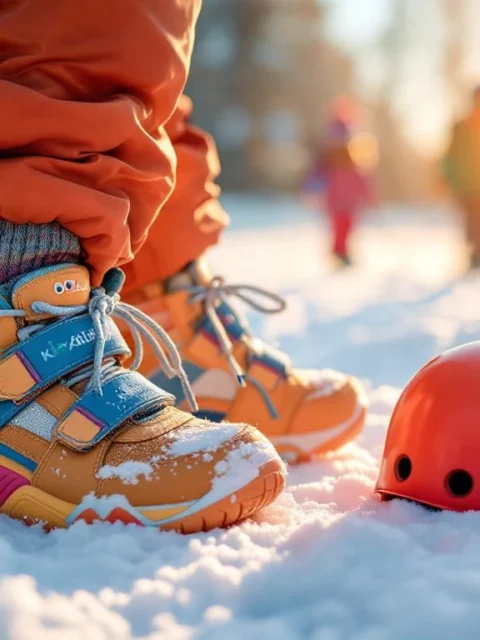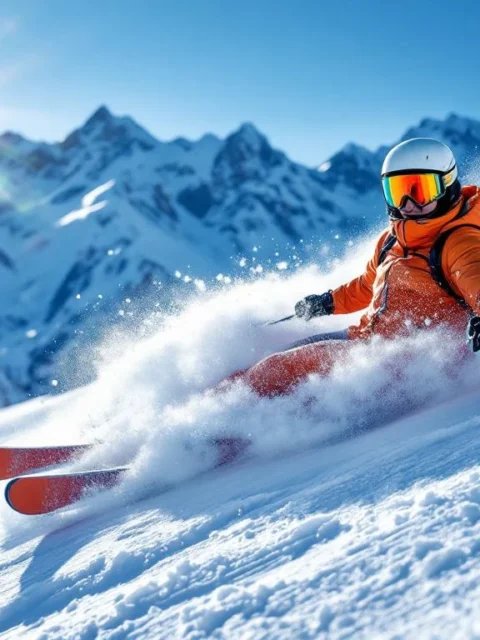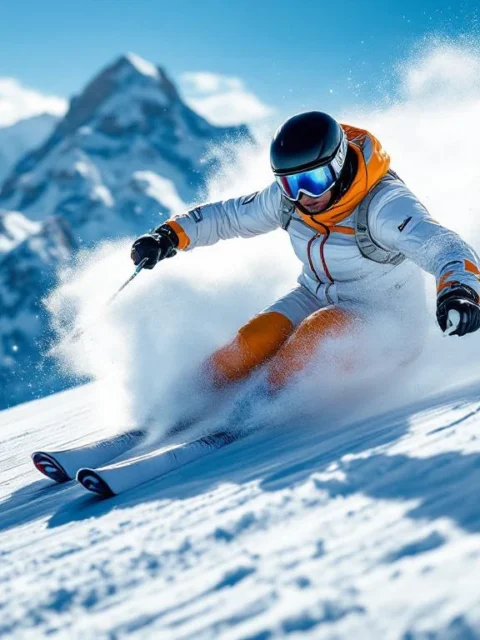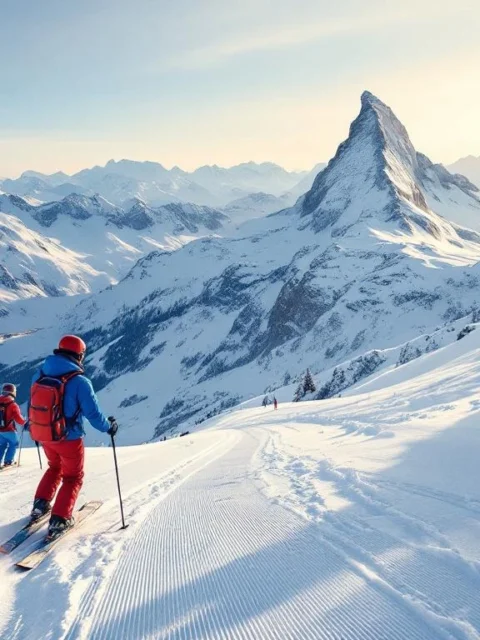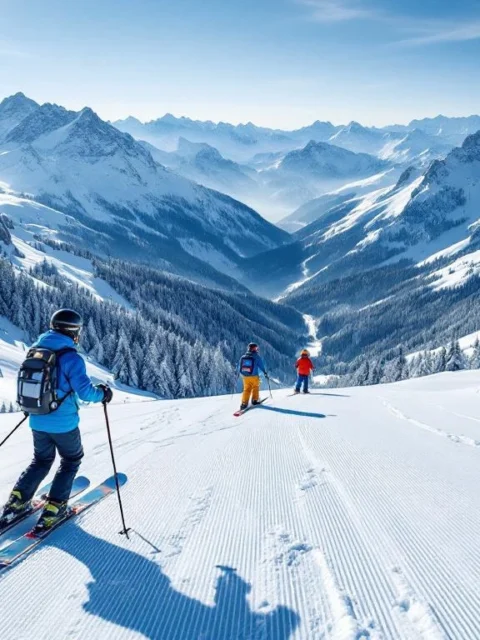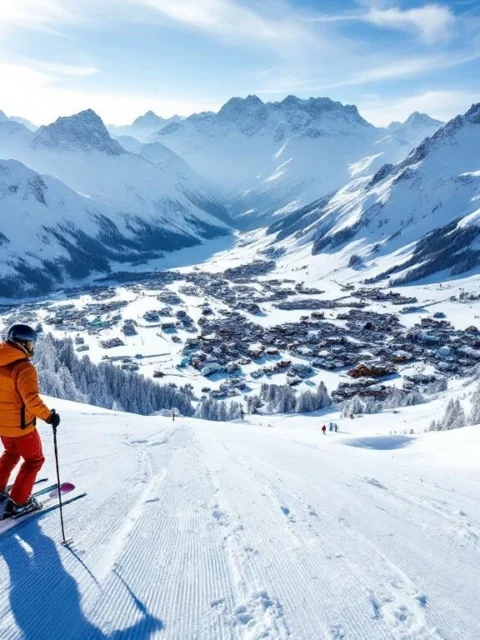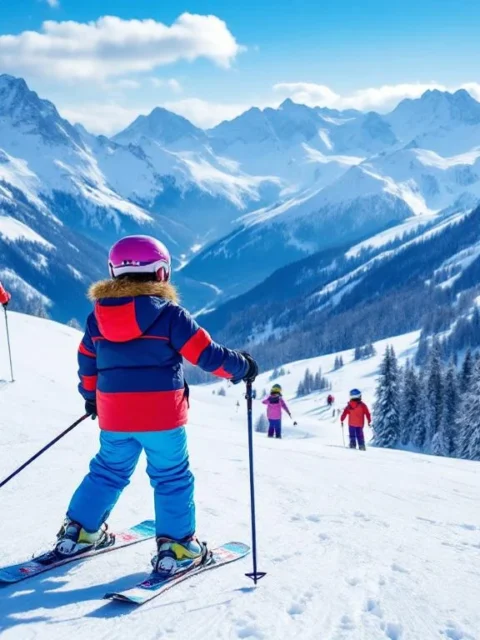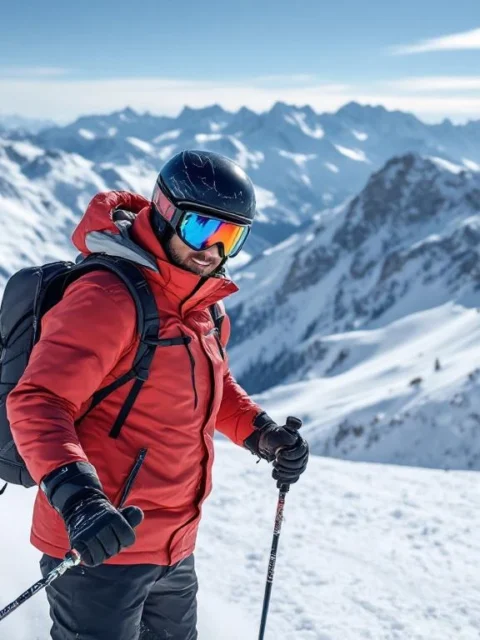Ski Lessons in the Dolomites: What Are the Advantages?

Ski lessons in the Dolomites offer unique advantages through the combination of breathtaking landscapes, varied terrain, and the typically Italian teaching style. This UNESCO World Heritage mountain range distinguishes itself through impressive rock formations that create a magical backdrop for your skiing experiences. The Dolomites are perfect for both beginners and advanced skiers, with excellent slopes, reliable snow conditions, and instructors who combine technical precision with a relaxed Italian flair. Additionally, between lessons, you’ll enjoy authentic gastronomy and warm hospitality.
Why are the Dolomites so special for ski enthusiasts?
The Dolomites are a paradise for ski lovers due to their unique geological features. This mountain range consists of light-colored dolomite rock that acquires an enchanting pink glow at sunrise and sunset—the famous “alpenglow” or “enrosadira” as the locals call it. This natural phenomenon alone makes skiing here an almost mystical experience that you won’t find anywhere else.
The UNESCO World Heritage status that the Dolomites received in 2009 confirms the exceptional natural beauty of this area. You’ll literally be skiing through a landscape of immeasurable value, surrounded by towering peaks and dramatic mountain walls that rise suddenly from green valleys.
What makes this region truly unique for winter sports enthusiasts is the combination of impressive nature with perfectly maintained slopes. The contrast between the rugged mountain tops and the excellently prepared descents creates a skiing sensation that you won’t experience anywhere else. The Dolomites offer a perfect interplay between pristine nature and modern ski facilities.
Moreover, the geological composition ensures exceptional snow quality. The porosity of the dolomite rock and the specific altitude differences provide excellent snow conditions, even when other Alpine areas struggle with snow shortages. This makes the Dolomites a reliable destination for quality ski lessons in a breathtaking environment.
What makes the ski areas in the Dolomites different from other Alpine locations?
In the Dolomites, you’ll experience a unique combination of Italian flair and Austrian efficiency that other Alpine regions cannot match. The most striking difference is the Dolomiti Superski network: one ski pass gives access to an impressive 1,200 kilometers of slopes spread across 12 different ski areas. This is the largest connected ski area in the world, meaning that during your ski lessons, you can explore an unprecedented variety of terrain.
The infrastructure in the Dolomites is among the most modern in Europe. The lift systems are fast, efficient, and often offer heated seats—a luxury you’ll appreciate on cold winter days. Unlike some French ski areas, where older lift systems are still common, Italian resorts continuously invest in the latest technology.
What truly distinguishes the Dolomites is the gastronomic experience. Unlike many other Alpine areas, where mountain huts often serve standard ski food, in the Dolomites, you’ll find authentic mountain restaurants serving local specialties. Between ski lessons, you’ll enjoy excellent Italian coffee, homemade pasta, and regional wines for a fraction of what you would pay in Swiss or French resorts.
Snow conditions in the Dolomites are surprisingly reliable, despite the relatively southern location. Thanks to advanced snow cannons and careful slope management, the Dolomites offer excellent skiing conditions even in less snowy winters. This reliability is essential for those who want to invest in ski lessons and be assured of good practice conditions.
The cultural experience in the Dolomites is special due to the unique mix of Italian and Austrian influences. In South Tyrol (Alto Adige), both Italian and German are spoken, resulting in a fascinating cultural landscape. You’ll feel this special atmosphere during your ski lessons, where precision and technique go hand in hand with a relaxed, enjoyable attitude.
Which skiing skills can you best learn in the Dolomites?
The Dolomites are particularly suitable for perfecting your carving technique. With perfectly prepared, wide slopes with consistent gradients, you can optimally work on making clean, carved turns. Instructors in the Dolomites are masters at teaching this technique, which is essential for elegant and efficient skiing on both blue and red slopes.
For beginning skiers, the Dolomites offer ideal learning conditions. The combination of gentle slopes and excellently prepared pistes ensures that you build confidence quickly. Many ski areas have specific beginner zones that are completely sheltered from busier slopes, allowing you to learn the basic techniques in peace without worrying about other skiers racing past you.
Advanced skiers can exceptionally well work on their technique in varying conditions in the Dolomites. The unique terrain offers a natural progression in difficulty level. You can start on well-prepared red slopes and gradually move to more challenging conditions, such as mogul fields and off-piste routes under the guidance of an experienced instructor.
The Sella Ronda, a famous ski route that circles the Sella massif, is perfect for improving your endurance and adaptive skiing techniques. During this approximately 40-kilometer tour, you’ll ski through four different valleys and across various types of terrain. This makes it an excellent training experience to develop your adaptability on different types of slopes.
Off-piste skiing takes on an extra dimension in the Dolomites due to the spectacular landscape. Under the guidance of qualified instructors, you’ll learn to safely navigate through pristine snow while surrounded by some of Europe’s most impressive mountain landscapes. The geological formations create natural couloirs and open bowls that are perfect for practicing various off-piste techniques.
For those interested in ski touring, the Dolomites offer an excellent introduction to this discipline. The combination of well-marked routes, reliable snow conditions, and breathtaking views makes this area ideal for learning the basics of ski touring under professional guidance.
How does teaching in the Dolomites differ from other ski schools?
The ski methodology in the Dolomites is characterized by a unique mix of technical precision and relaxed Italian flair. Unlike some French or Swiss ski schools, where the emphasis is often strongly on strict technical correctness, instructors in the Dolomites opt for a more holistic approach. They teach you not only the right movements but also how to ski with pleasure and elegance.
Italian ski instructors are known for their warm, personal approach. They quickly build a rapport with their students and adapt their teaching method to your personality and learning style. This personal touch ensures that you feel comfortable quickly and make faster progress than in more formal learning environments.
A notable difference is the attention to the “bella figura” concept—the idea that skiing should not only be technically correct but also look beautiful and elegant. Unlike some northern ski schools, where functionality is the primary focus, instructors in the Dolomites pay attention to the aesthetics of your skiing style. This leads to a more fluid, graceful way of skiing that is not only effective but also looks fantastic.
Lessons in the Dolomites often have a more relaxed pace, with time for breaks to enjoy the landscape or an espresso on a sun-drenched terrace. This doesn’t mean the lessons are less effective—quite the contrary. Through this balance between intensive practice and relaxed enjoyment, you stay mentally fresh and absorb new techniques better.
A special aspect of ski lessons in the Dolomites is the integration of cultural and historical context. Instructors are happy to talk about the history of the region, the names of the mountains, and local traditions. This enriches your skiing experience and gives you a deeper understanding of the area you’re skiing in.
The multilingualism of many instructors in the Dolomites is a major advantage. In South Tyrol, many instructors speak not only Italian and German but also excellent English and often Dutch. This ensures smooth communication and makes it easier to understand subtle technical instructions.
The focus on fun and enjoyment during the learning process is perhaps the most important characteristic of ski lessons in the Dolomites. Instructors understand that you’re on vacation and want you to appreciate every minute on the slopes. This positive, relaxed atmosphere accelerates the learning process and ensures that you develop new skills with a smile.
For those who want to get the most out of ski lessons in the Dolomites, we can help you find the perfect instructor who matches your level and learning style. At Ski-Pro, we connect winter sports enthusiasts with qualified ski schools and instructors in the most beautiful ski areas of the Alps, including the majestic Dolomites. Whether you’re a beginner or an advanced skier, the unique combination of impressive landscape, excellent slopes, and the characteristic Italian teaching style makes the Dolomites an unforgettable destination for your next ski vacation.
Frequently Asked Questions
What is the best period to take ski lessons in the Dolomites?
The optimal period for ski lessons in the Dolomites runs from mid-January to early March. During this period, the slopes are typically in excellent condition with reliable snow, the ski areas are less crowded than during the Christmas period, and the days are already somewhat longer. February is ideal for beginners due to stable weather conditions, while March is perfect for advanced skiers who want to enjoy sunny days and softer snow conditions.
How do I best prepare for my first ski lesson in the Dolomites?
Prepare physically by starting exercises focused on leg muscles and balance 4-6 weeks in advance. Invest in good basic equipment or rent it locally (a good helmet is essential). Explore the ski area where you'll be taking lessons online beforehand and learn some basic terms in Italian or German. Inform your instructor about any physical limitations or fears. Start the day before your first lesson with light stretching and ensure you're well-rested and hydrated.
What if I encounter bad weather conditions during my ski vacation?
The Dolomites offer excellent alternatives during bad weather. Many areas have indoor facilities where you can improve your technique. Use these days for technical drills instead of long descents. Consider taking a private lesson instead of group lessons during poor visibility - an instructor can help you navigate and build your confidence. Most ski schools also offer flexible rebooking options if lessons must be canceled due to extreme weather.
How can I best deal with altitude differences and acclimatization in the Dolomites?
Start your ski vacation calmly and don't plan your first ski lesson on your arrival day. Stay well-hydrated during the first two days and limit alcohol consumption to promote acclimatization. Begin with ski lessons at lower altitudes (below 2000m) and gradually work toward higher areas. Consider taking shorter lessons during the first days and build this up as your body adjusts to the altitude. If you experience symptoms of altitude sickness (headache, dizziness), immediately descend to a lower altitude and rest.
What cultural etiquette is important to know before taking ski lessons in the Dolomites?
Punctuality is valued in the Dolomites; arrive on time for your lessons. A small tip for your instructor at the end of multi-day lessons is appreciated but not mandatory. It's customary to address your ski instructor as 'Maestro' (Italian) or 'Skilehrer' (German) as a sign of respect. During lunch breaks, it's normal to eat with your instructor and have a conversation - this is part of the social skiing experience in Italy, not just a break.
How can I maintain the skiing techniques I learned in the Dolomites after my vacation?
Take notes or videos of your lessons to remember the most important techniques. Invest in a short refresher course at an indoor ski hall before planning your next winter sports trip. Specific balance exercises such as one-leg squats and core stability training help maintain your skiing muscles. Consider staying in contact with your instructor via online platforms - many Dolomite instructors offer off-season video analyses or training schedules. Plan an annual ski vacation to consistently continue developing your skills.
What are the hidden costs I should consider when booking ski lessons in the Dolomites?
Besides lesson costs, consider the ski pass (not always included), equipment rental, and insurance. Private lessons may seem more expensive but can be cost-effective if you progress faster. Mountain lunches can be costly; consider bringing some snacks. Transportation between accommodation and ski school can be a hidden expense - check if your accommodation offers a shuttle service. For maximum value, book lessons early in the season (up to 20% discount) and consider package deals that combine lessons, equipment, and ski pass.


